
‘The camera doesn't make a bit of difference. All of them can record what you are seeing. But, you have to SEE’
Ernst Haas
I don’t know about your child, but mine really is the cutest, sweetest, smartest thing alive.* (*OK, OK, so is yours). When I look at her, all I see is this gorgeous smile. And as far as photography goes - THIS, right here is a part of every parent’s problem.
You see, I KNOW that your child does the same thing to your brain. The moment we see them, everything else disappears and all we see is their beautiful face. We call it Mummy ( or Daddy) Goggles.
Here is what happens: we take in the whole scene, but only pay attention to those details that matter to us, pushing the rest out of our field of vision. And as parents, there is simply nothing in the world that matters more to you than your child. But your camera just cannot do the same. It doesn't have emotions. It doesn't know what matters to you. You need to tell it. Otherwise, it'll record that stray sock, toys spilling out of the cupboard and a bit of an unidentified foot as well as your precious baby.
What’s more, YOU see a 3-dimensional world, with familiar proportions and intuitive sense of your space. But your camera will record just a small fraction of that. It may make sense to you when you look back at the photo ( after all you WERE there when it was taken) but perhaps less so to the person who only has the photo to go by.
So we’re starting this course with helping you see the world a bit more like your camera, with the final picture in mind, and we’regiving you 3 simple solutions that will help you get there
The PROBLEM :
the background of your photos is too cluttered
I know what you’re thinking. “but there are always things around my child” “My house isn’t an empty box"
That’s fine. It shouldn’t be. You’re not doing a studio shoot. Some details tell us about the place and the time and they are important. But some just aren’t.
Here is what a typical ‘I only see my child’s gorgeous face” photo looks like. Looks familiar?
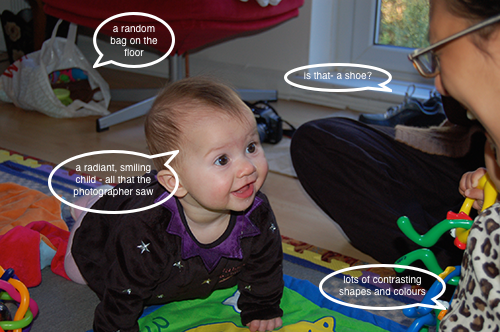
OK, so part of it is Mummy Goggles and just not seeing the mayhem around your child. But if you do see it, and so does your camera, then what? You can't / don't always want to move your child and trying to keep the child-related clutter out of the frame while entertaining a child is a little like trying to brush your teeth while eating chocolate, so what can you do? A few things actually.
SOLUTION 1 :
ZOOM IN - yes, even if you are already close
OK, this is important : your camera sees more than you do
This means, first and foremost, that some of the clutter that made it into your photos was not entirely your fault. You just didn't see it.
Consider these two photos, but I want you to pay attention not to the child in the image, but to what's behind her. Notice how much more background shows in one of the photos compared to the other? And how much more blurry some of the background appears?
No zoom
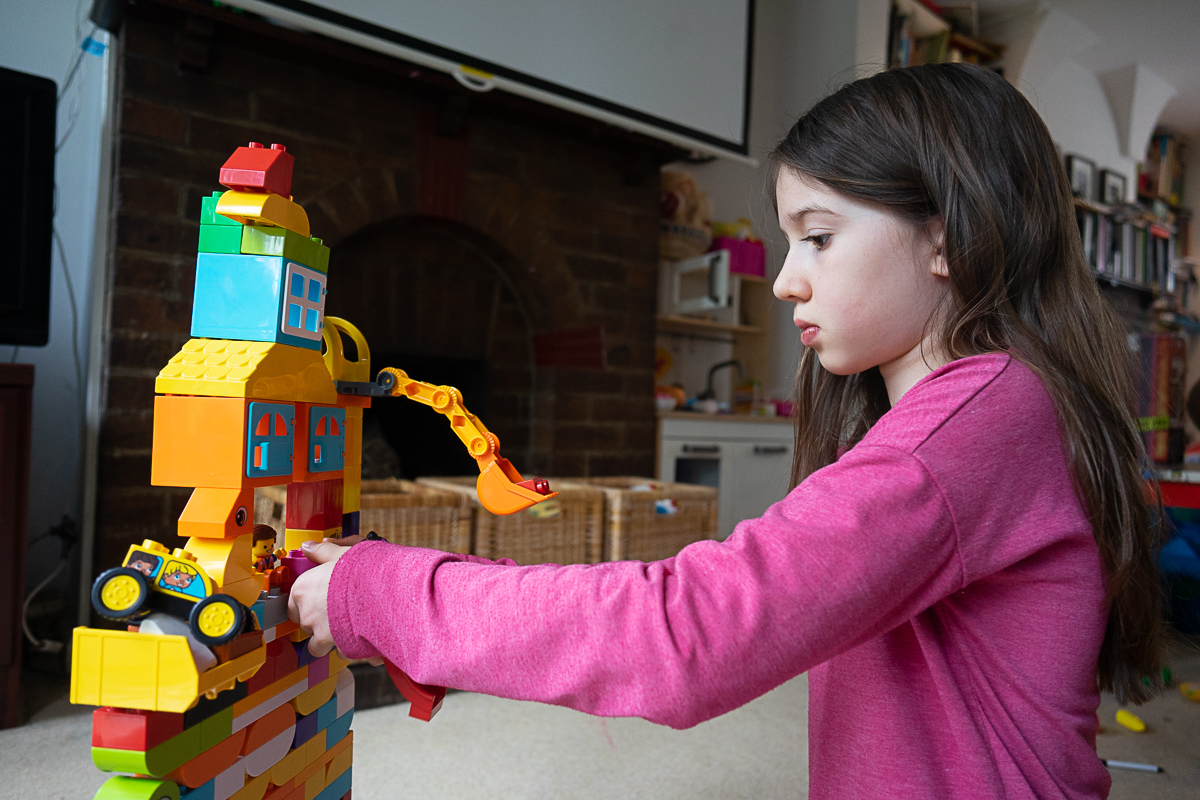
Zoomed in
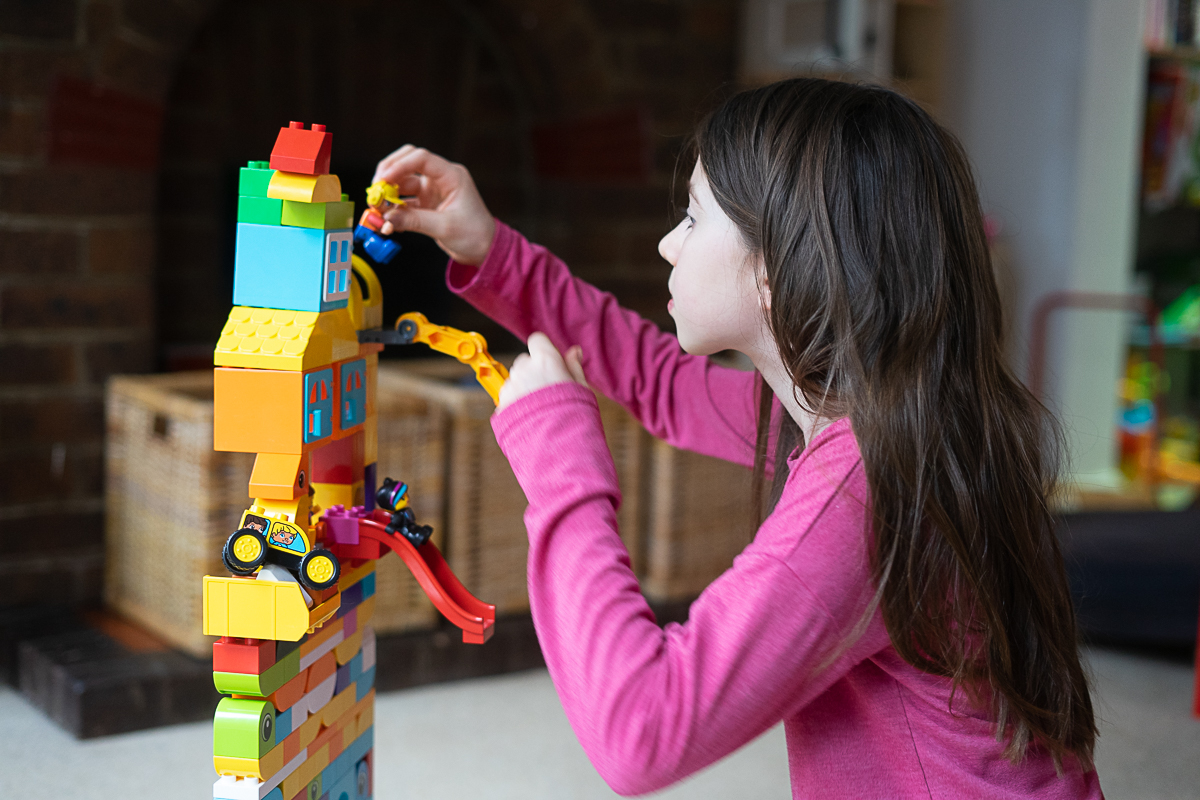
Notice how much more background 'fits' behind the girl in the first image, compared to the second. The only diference being - the zoom. In the first image we didn't zoom in at all, and the field of view = how much from left to righ, top to bottom does your camera see - was quite considerable. In the second image, we stepped back away from the girl to keep the proportions of her in the images the same when we zoomed in, and notice how the area behind her just shrunk. And not only that - it has grown more blurry too in the process. All of which can help minimise distractions from your subject.
Let me explain what happened here:
Without going into technical details: when you keep your zoom 'unzoomed' ( it's a word, OK?) - because maybe you're close to your subject anyway, so why would you be zooming in? - when you keep your zoom unzoomed, your camera can often see MORE than you do with your naked eye.* It has a peripheral vision that's wider than yours, so it'll be seeing more on both sides and top and bottom.
But there is more: it might even make the space you see in front of you, LARGER than in real life (estate agent's favorite trick). Ever been to a see a flat / house that looked spacious on photos and then turned into a broom cupboard in real life? THAT.
But if you're not trying to sell a house, the outcome for your photos is this: when you do not use your zoom, your camera will be showing more in the foreground and background of your photos than you might be willing to show.
But by zooming in, you narrow down the camera's peripheral vision AND also visually compress the space, tightening what you see in the background. So you can visually cut out half of your clutter simply by zooming in and taking a few steps back. Magic.
* I refer here to what you would get with a standard lens that would typically be supplied with your camera. If you are using a different, longer zoom or prime lens, you might be seeing slightly different things.
Does it work the same on my phone camera? It depends on wthether your pohone camera has a 'real' zoom - aka Optical zoom, or 'pretend' zoom - aka Digital zoom. In the first case, there is a change to the tiny lens itself when you zoom in and that causes the change in how the camera sees the world. In the second case, we're just stretching pixels to make the subject in the frame larger. The equivalent of pinching and stretching the image on a ready made photo.
SOLUTION 2 :
MOVE. You - not the subject.
We often assume that when your child is somewhere with lots of clutter, in order to eliminate it from the image, we need to move the child.
In some situations - yes, thats the right thing to do. Bot often, your child is engrossed in play and won't take kindly to being asked to move.
But we forget that so much of what we see depends on our point of view. Sometimes the tiniest adjustment of your position will be enough to make a massive difference. One step to the left or right, or slightly adjusting your camera angle can eliminate a ton of unwanted rubbish.
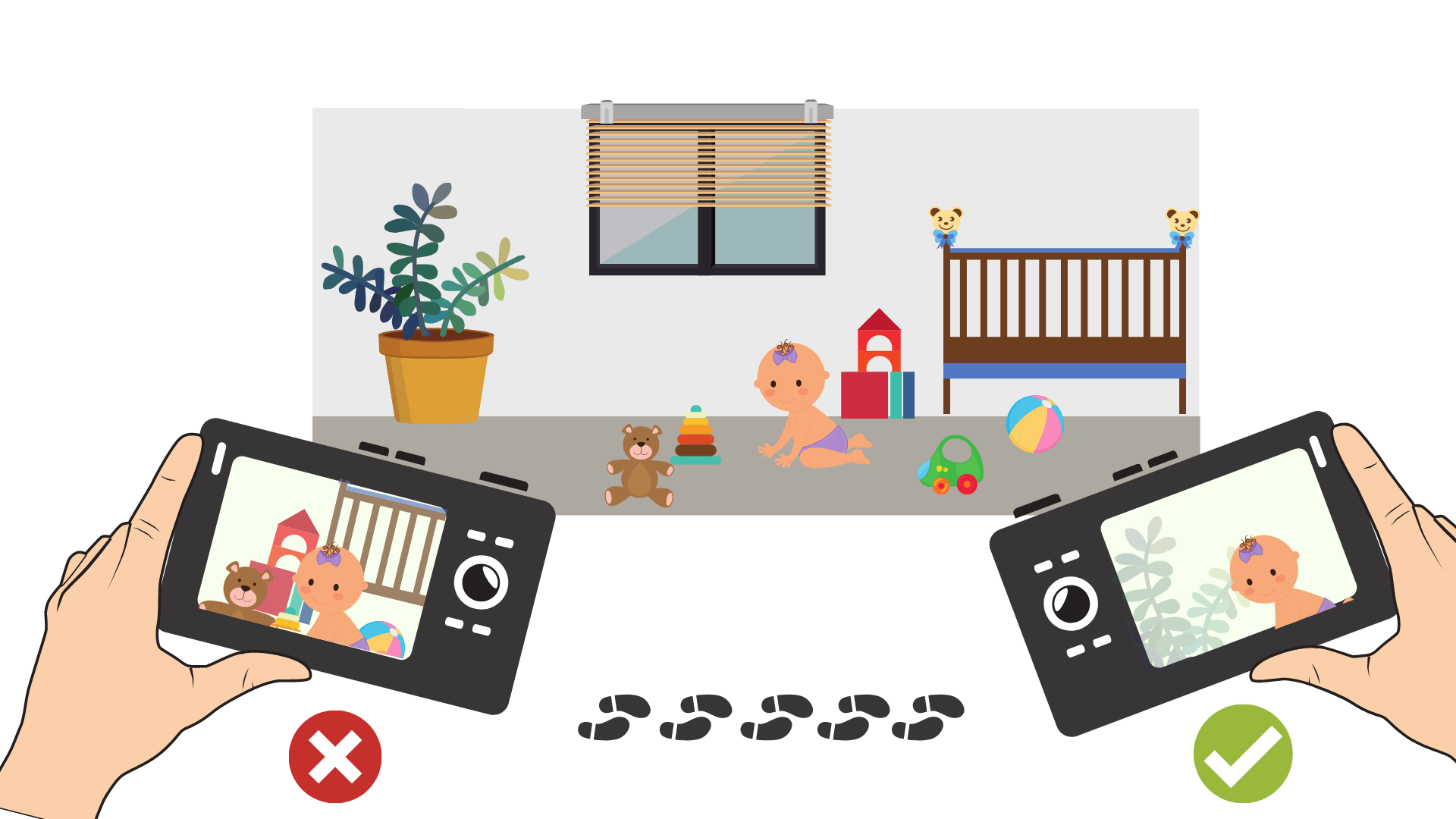
SOLUTION 3 :
Change your shooting angle
I know, right? A no brainer. And yet.....
90% of Britain’s family photos are taken from 5 foot high and 5 foot away. FACT. Probably.*
Most adults, when taking a photo of a child will simply assume the “upright - standing comfortably” position and expect the world to adjust. And the result? Boring photos with lots of background clutter, lots of floor and not a lot of depth. But more so than that - the perspective is off, and so are the proportions and the final result is less than inspiring.
Understanding how your shooting angles make a difference to your final photograph will serve you well, whatever you photograph. Often it's the easiest thing you can do and will make a massive difference whether you are shooting with your camera or your phone.
Let us give you a few pointers on what great angles you might want to choose:
Eye level with your subject
One of the biggest bug bears I have with bad kids photography is the height of your angle. You shouldn't be taking the photo where it's comfortable for you - you should be taking it so that it's at the level of your subject. I would really really love you to stop shooting from your height level and get down on the floor and shoot at a flatter angle parallel to the floor. It helps you build in-depth and gives you more control of the background and keeps the person's proportions more natural.
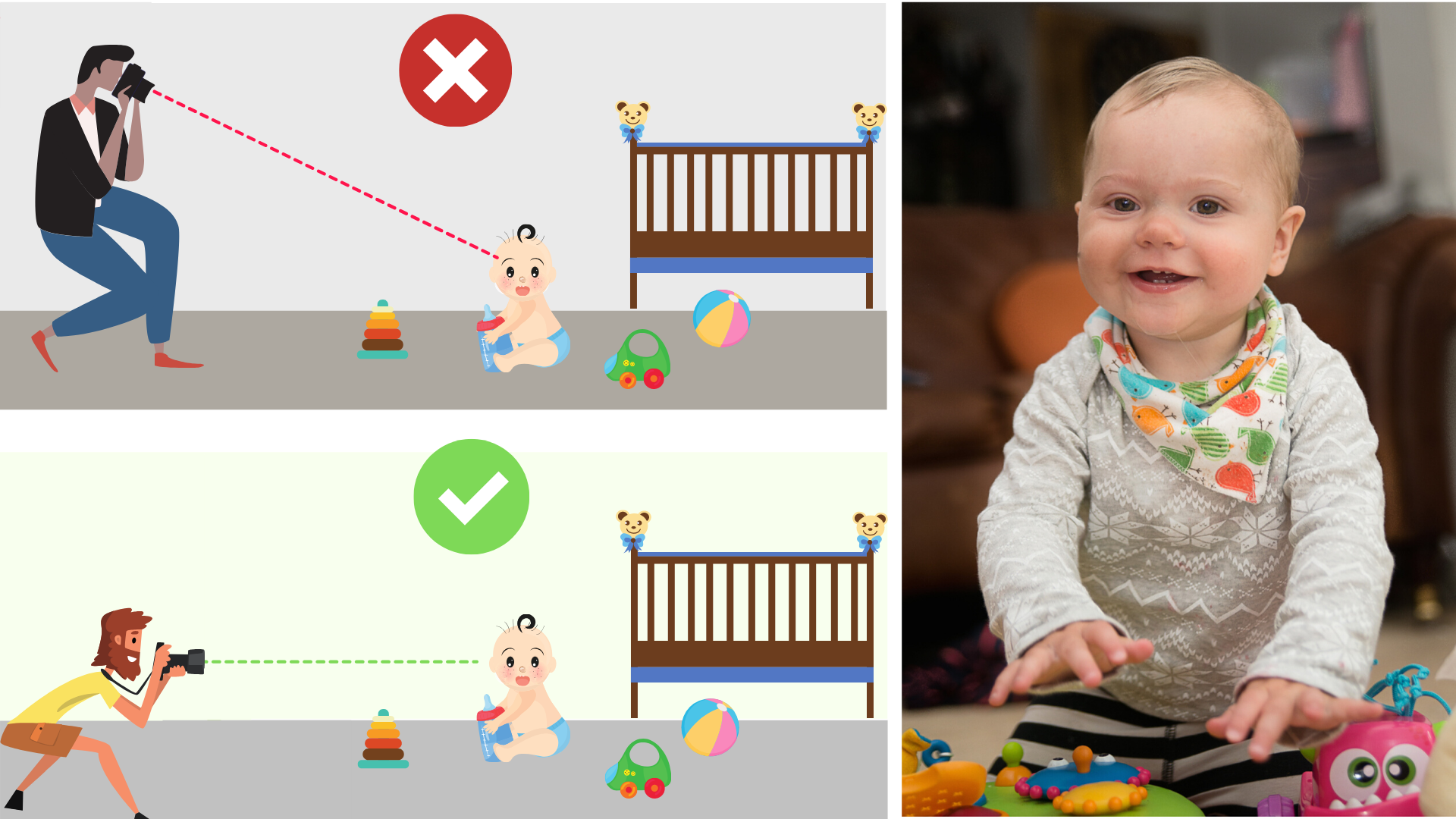
Try an Ants View
A variation of the 'leveling up, but going even lower. Place your camera on the floor and let it do its job. It will capture some of the floor ( and blur some if it out) as well as your subject. In this case, I'd actually suggest keeping your zoom down to the lowest ( = not zoomed in) . You might need to subtly adjust the angle as well if you're getting too much floor.
The benefit of this angle is that you can use the ground in a way that can create an interesting textural contrast to your subject and what would otherwise be clutter, is raised to the 'context or the image' level.



Birds Eye View
Yes, I know this goes against all that I suggested earlier but hear me out. When you do a PROPER birds eye view, that means raise your camera DIRECTLY above the subject, you reduce the amount of clutter your camera sees. And what it does see is easier to control because you're only dealing with a small rectangle of your floor space. So it might be mayhem everywhere else, but on that little piece of space it's all calm, space and beauty.




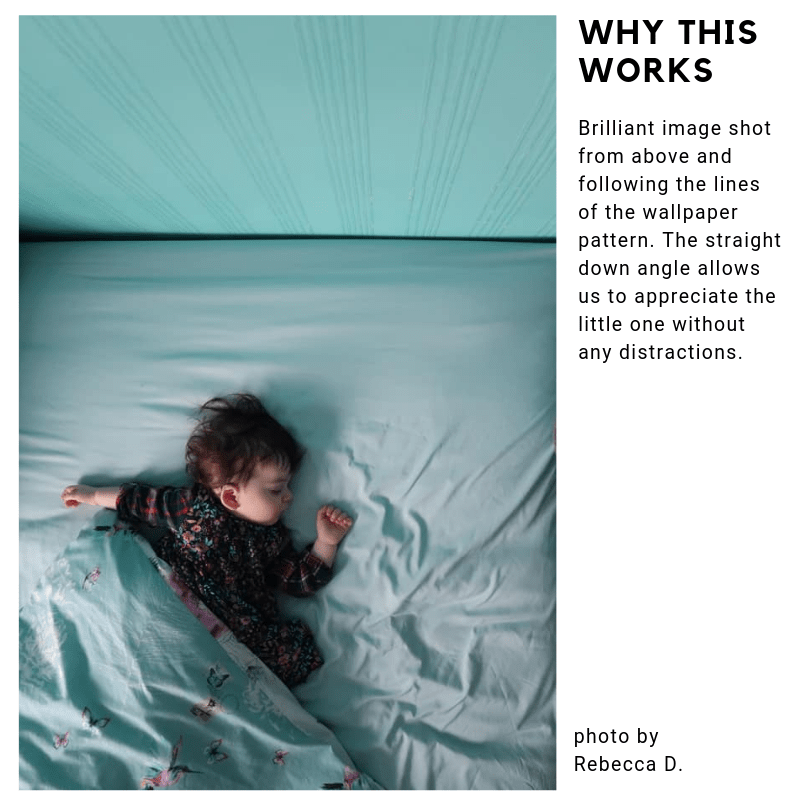
And all together now:
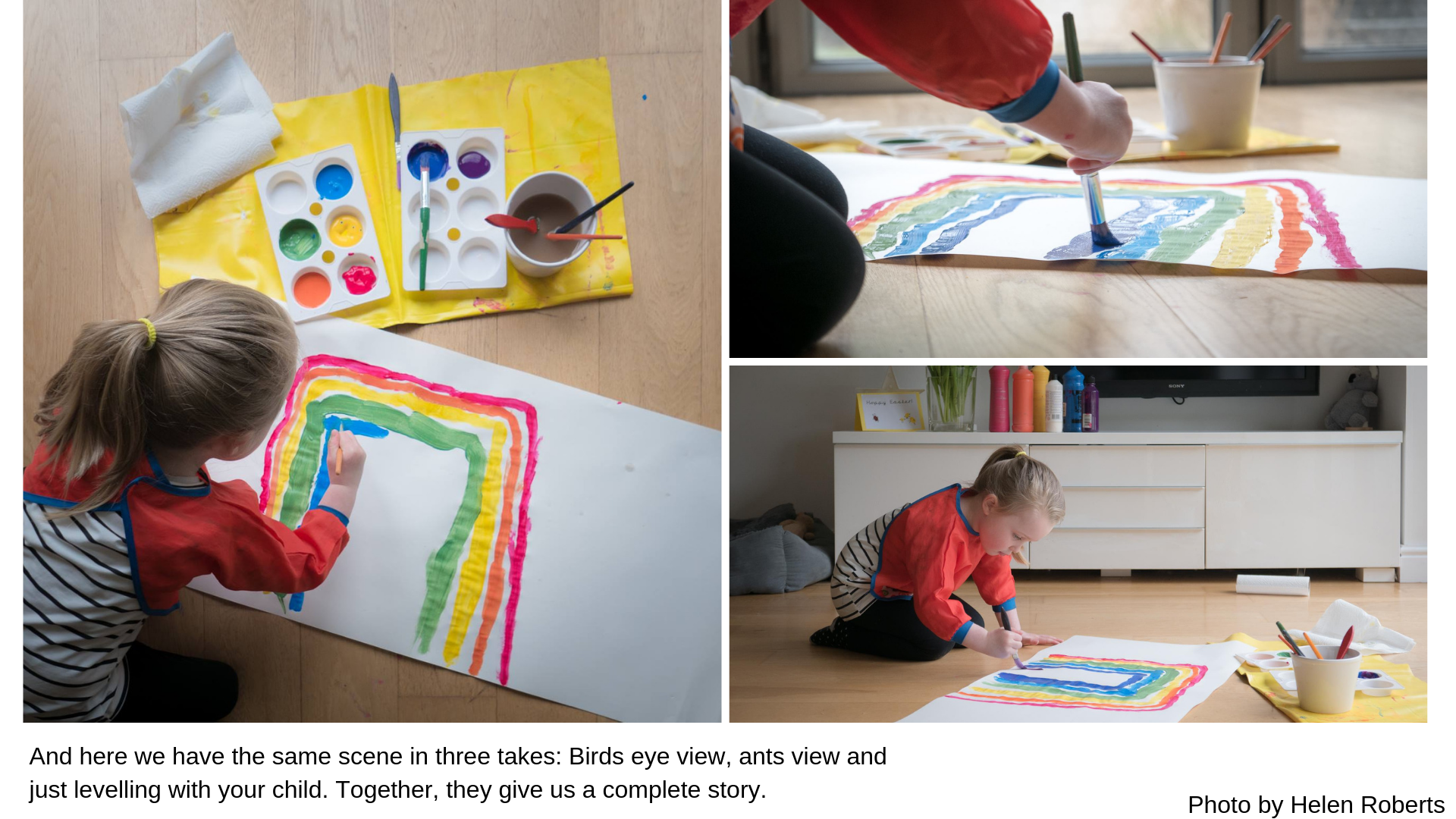
OVER TO YOU:
Lesson 1 Challenge
Capture your child / children today from at least 3 different angles. Try out those flat, 'level with your child' angles, those 'birds eye view' and 'ants view' angles.
And with that, I want you to pay attention to how much or how little clutter you are including in your images - if it feels like too much of it is getting in consider our solutions: zoom in, change your position, change your angle, switch between vertical and horizontal and do your best to take off yoru Mummy / Daddy goggles!